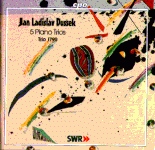Jan Dussek’s music is mostly overlooked by today’s general public, largely because much of it seems to pander to long-outdated tastes. These five Sonatas for piano, violin, and cello won’t do much to alter that perspective, but they nonetheless deserve attention as examples of the work of a respected contemporary of Beethoven, Haydn, and C.P.E. Bach, who was a well-travelled and brilliant keyboardist and composer. The music is nearly on the level of Beethoven’s Op. 1 trios in formal sophistication, but without the emotional intensity. Melodies are noticeably “lighter”, technical demands less challenging. However, the use of period instruments by the fine musicians of Trio 1790 sheds light on these pieces that reveals some rather charming qualities.
All the works are in sonata form, in two or three movements, and the piano is the obvious star of the show. The 1790 pianoforte is wholly appropriate for the lighter fare of the Sonata Op. 20 No. 3, and the thinner sound of the instrument makes the parlor tune cantabile of the second movement more believable, especially as it sets off the lovely violin line. With the full voice of a modern piano, this music would just sound trite. The violin does, howver, get a couple of chances to shine, most noticeably in the opening of the Sonata Op. 31 No. 3, and the third movement of the Op. 24 No. 3, a theme and variations on a Paisiello aria.
The three Sonatas Op. 31 feature a different, more modern (ca. 1800), richer sounding pianoforte, and it’s a good thing too, because Op. 31 No. 2 is actually written for piano solo. The extended bass gives essential body to the lower end, and overall there is much more of a core to the sound–an advantage in bringing sufficient brilliance to the upper registers. Pianist Harold Hoeren produces some delicate tonal shading here and uses some tasteful pedaling in the final movement, which is an excellent example of a Scotch Reel done up for public consumption. The sound is excellent, with fine balance and natural placement of the instruments. In the Op. 31 No. 3 the violin and cello often blend together in a drone, sounding much like a glass harmonica (a favorite of Dussek), and the recording splendidly captures this effect.
































